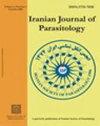Expression of Heat Shock Protein 70 (HSP70) and Astacin Genes of Strongyloides stercoralis as well as HSP70 and HSP17.1 Genes of S. ratti in Adult and Larval Stages of S. stercoralis
IF 0.9
4区 医学
Q4 PARASITOLOGY
引用次数: 0
Abstract
Background: Uncovering the roles and characteristics of pathogenesis-related molecules can help us develop novel management methods in parasitology. In this study, we studied the expression levels of Strongyloides stercoralis heat shock protein70 (HSP70) (Sst-hsp-70) and astacin (Sst-ast) as pathogenesis-related genes as well as the expression of S. ratti HSP70 and HSP17.1 (Sra-hsp-70, Sra-hsp-17.1) in the larvae and adult stages of S. stercoralis. Methods: A hyperinfection isolate of S. stercoralis from Gilan Province, northern Iran was cultivated on nutrient agar. After a couple of days, parasites in different stages of life were collected, and total RNA was extracted. The expression levels of astacin and HSP genes were compared by real-time PCR. Results: Statistically higher expression levels of Sst-ast, Sst-hsp-70, and Sra-hsp-70 genes in L3 larvae than in adults were observed. However, the expression level of Sra-hsp-17.1 was non-significantly lower in the larval stage than in adult worms. Conclusion: Higher expression levels of Sst-ast, Sst-hsp-70, and Sra-hsp-70 genes in the larval stages of S. stercoralis suggest the potential role of these enzymes in parasite cutaneous invasion and pathogenesis. However, higher expression of Sra-hsp-17.1 in adult forms is probably involved in resistance and survival mechanisms. The similarity in gene expression between S. stercoralis and S. ratti can provide helpful hints to better understand strongyloidiasis from various perspectives, including pathogenesis, proper diagnosis, and targeted treatment.盘尾丝虫的热休克蛋白 70 (HSP70) 和 Astacin 基因以及 S. ratti 的 HSP70 和 HSP17.1 基因在成虫和幼虫阶段的表达情况
背景:揭示致病相关分子的作用和特征有助于我们开发新的寄生虫学管理方法。在这项研究中,我们研究了盘尾丝虫热休克蛋白70(HSP70)(Sst-hsp-70)和astacin(Sst-ast)作为致病相关基因的表达水平,以及S. ratti HSP70和HSP17.1(Sra-hsp-70, Sra-hsp-17.1)在盘尾丝虫幼虫和成虫阶段的表达情况。研究方法在营养琼脂上培养产自伊朗北部吉兰省的高感染株盘尾丝虫。几天后,收集处于不同生命阶段的寄生虫并提取总 RNA。通过实时聚合酶链式反应(real-time PCR)比较了 astacin 和 HSP 基因的表达水平。结果显示据统计,Sst-ast、Sst-hsp-70 和 Sra-hsp-70 基因在 L3 幼虫中的表达水平高于成虫。但是,Sra-hsp-17.1 基因在幼虫期的表达水平比在成虫期低,差异不显著。结论盘尾丝虫幼虫期的 Sst-ast、Sst-hsp-70 和 Sra-hsp-70 基因表达水平较高,表明这些酶在寄生虫皮肤入侵和致病过程中可能发挥作用。不过,成虫体内 Sra-hsp-17.1 的表达较高,可能与抵抗和生存机制有关。盘尾丝虫和拉蒂丝虫基因表达的相似性为从发病机制、正确诊断和针对性治疗等多个角度更好地了解强丝虫病提供了有益的提示。
本文章由计算机程序翻译,如有差异,请以英文原文为准。
求助全文
约1分钟内获得全文
求助全文
来源期刊

Iranian Journal of Parasitology
PARASITOLOGY-
CiteScore
1.80
自引率
0.00%
发文量
55
审稿时长
6-12 weeks
期刊介绍:
Iranian Journal of Parasitology (IJP) is the official publication of Iranian Society of Parasitology (ISP) launched in 2006. The society was inaugurated in 1994 and pursues the improvement of the knowledge on the parasites and parasitic diseases, exchange of scientific knowledge with foreign societies, publicity activities, and consultation on the parasitic diseases, and intimate relationship among society members.
The main aims of the Journal are: contribution to the field of Parasitology, including all aspects of parasites and parasitic diseases (medical and veterinary) and related fields such as Entomology which may be submitted by scientists from Iran and all over the world.
 求助内容:
求助内容: 应助结果提醒方式:
应助结果提醒方式:


